From the book: All That Glitters by Emilia Potenza
During the course of the last century, industrialisation has affected the lives of everybody living in Southern Africa shaping the society we live in today. This feature examines the process of industrialisation in South Africa.
Industrialisation describes a complicated process of change. This process has unfolded in a variety of ways across different countries. In this article many aspects of industrialisation are discussed that are aimed at making clear what industrialisation means.
In the late 19th Century, South Africa changed rapidly from an agricultural society, where most people lived off the land, to an industrial society. This took place largely as a result of the discovery of large diamond deposits in Kimberley in 1867 followed in 1886 by the discovery of gold on the Witwatersrand.
 Mineral discoveries in South Africa
Mineral discoveries in South Africa
Southern Africa was not the first part of the world to industrialise and came quite far behind in the industrial revolution.
Over the last two hundred years, many countries underwent industrialisation. Britainwas the first of these. Unlike the experience in South Africa, industrialisation in Britain was a slow process taking place over two centuries.
A central aspect of Britain's transformation into an industrialised one was the establishment of mass production. This process changed the face of people's lives.
These events and their impact on British society may be compared to the experience of industrialisation in South Africa. There are similarities and differences. Britain also played a role in the industrialisation in South Africa.
Life in Britain before the Industrial Revolution
British society during the Middle Ages (1100-1500) was made up of two main divisions, the serfs and the nobles. The serfs worked on land owned by the nobles. In exchange for the use of a piece of the noble's fields and for protection in times of war, a serf had to give some of his produce or his labour to the noble. This arrangement between nobles and their serfs is called the feudal system.
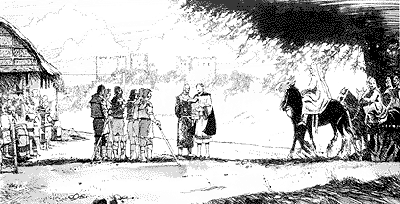 A nobleman and his soldiers meeting with serfs
A nobleman and his soldiers meeting with serfs
By 1750 Britain was no longer a feudal society. The serfs had won their freedom from the nobles. Many now had their own small farms and became known as peasants. Peasant farmers owned farm tools and animals and separate family plots. They usually managed to grow just enough food in unfenced fields to feed themselves and their families. When there was a surplus, they sold it in towns.
Other peasants worked as tenant farmers on land belonging to rich landlords. These farmers usually paid rent to landlords. Because of the size of their farms and the scale of their production they often employed farm labourers to help them. Tenant farmers were responsible for producing most of Britain's food.
In England, farm labourers formed the majority of the rural population. They depended on wages they received from working for tenant farmers but could also still use common land. This played a very important role in their lives. It provided them with plots on which to grow some food, grazing land for their animals and firewood, clay and thatch for building.
Some people took on a second job weaving woollen cloth in their homes. Most of these were the wives of farm labourers. They needed to earn extra money, to supplement their husbands wages. This became known as the cottage industry. Some people regard this as the first form of industry in Britain.
The son of a weaver remembers:
The weavers had their good times. The atmosphere was not fouled by ... the smoke of the factory. There was no bell to ring them up at four or five o'clock ... There was freedom to start and to stay away as they cared . In the evenings, while still at work at anniversary times of the Sunday schools, the young men and women would most heartily join in hymn singing, which the rhythm of the looms* would keep time. Quoted in The Making of the English Working Class
by E.P. Thompson. 1968.
In spite of taking in extra work, most people living in England at this time were poor and lived in very simple dwellings. This next source describes what cottages in the rural areas of England were like even in the 19th century:
What a mighty space lies between the palace [of the rich landowner] and the cottage in this country ... In the cottage, you will find naked walls, bare brick, stone or mud floor ... a few wooden, or rush bottomed chairs, an old oak table, a simple fire place, with its oven beside ... a few pots and pans and not much more. From The Rural Life of England by William Howitt
The city of London
The only large city in England in the 1700s was London with a population of about 500 000 people. There were luxurious houses and streets in London's fashionable West End where doctors, bankers, lawyers and merchants lived. In contrast to this the East end was home to large numbers of poor people living in poverty and filth.
Overseas colonies
By 1700 Britain already had taken control of a number of overseas countries, as colonies. These colonies were mainly in North America and the Caribbean. They provided raw materials like cotton, tobacco and sugar, from which goods could be manufactured in Britain. These colonies were also places where British manufactured goods could be sold.
Growing and processing crops such as cotton, tobacco and sugar was labour intensive. With the shortage of labour, landowners and officials of the colonies decided to resolve this by importing slaves from West Africa. Over two million people were forced from Africa to work on plantations in British America until the slave trade was abolished in 1834.
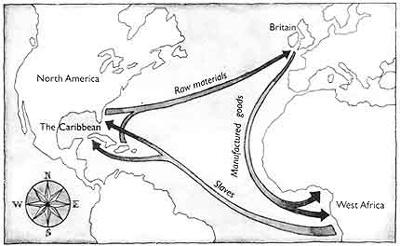 Britain's trade triangle
Britain's trade triangle
Britain's Industrial Revolution
There has been much debate on why Britain was first country in the world to industrialise. Different historians have different views.
Possible causes are:
- The increased demand for manufactured goods
- A new government policy of not interfering in trade and industry (called laissez-faire, meaning 'leave alone')
- Important developments in science and technology, e.g. the steam engine, the power looms the miner's safety lamp
- Changes in the scale and methods of agriculture
- A population explosion
- The fact that Britain was at peace during this time.
This article does not focus on the causes of Britain's Industrial Revolution. Instead, it explores the impact this had on ordinary people's lives through the changes brough in by industrialisation.
The Industrial Revolution in Britain saw the development of towns and cities. Families no longer worked in and around their homes as people moved to the cities to be nearer to the large factories where they could find work. This painting below byL.S. Lowryin 1930 shows some of the features of an industrial city.
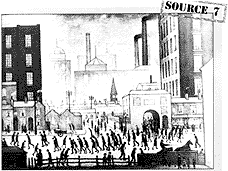
Changes in agriculture
Agriculture in Britain began to change in the 16th century. Some landlords realised they could make money by controlling the growing of crops and the keeping of animals on a large scale, and then selling them for profit. They decided to do this instead of simply owning land and letting others work it for themselves.
The next item deals with laws that were passed by the British government from 1750 onwards that forced many people off the land.
From the countryside to the towns
The Enclosure Acts resulted in fewer jobs in the countryside. This meant that many people were not able to get work as farmers and had no option but to go to the developing towns or urban centres in search of work in the mines and the factories. The result was that people moved permanently from the rural areas to the urban areas. This process is known as urbanisation.
The growth of the coal mining industry
In many areas of Britain there were vast amounts of coal. Coal provided power for the new machines. When some landowners discovered coal on their estates in the late 1700s, they were willing to invest money to mine it. The only way the coal could be reached was by digging vertical shafts. Many men, women and even children were employed by these landowners to dig the shafts and then mine the coal.
The development of factories
Some of the earliest factories in Britain were textile factories. These factories were set up in the 1770s to manufacture cloth and clothes from raw materials like wool, cotton and silk. Over time, textile factories replaced cottage industry. It was much more efficient to gather the spinners in one place and saved the time spent carrying raw materials and finished goods from one home to another.
| Before | After |
|---|---|
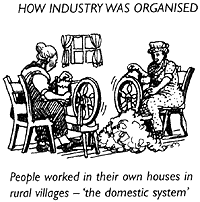 |
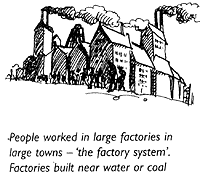 |
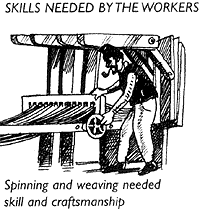 |
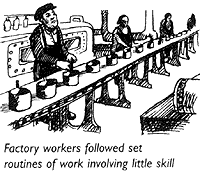 |
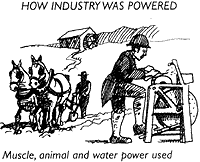 |
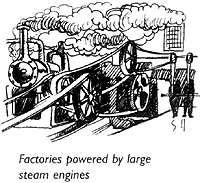 |
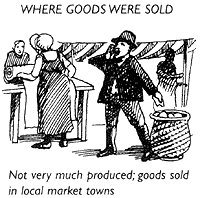 |
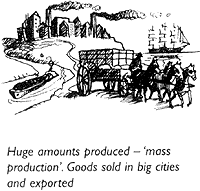 |
The development of other manufactuting followed. For example anchors and nails using the coal and iron mined in the north. More and more people were employed in factories manufacturing goods for sale.
Factories introduced a major change in the way production was organised. Before the rise of factories, most goods had been produced on a small scale by skilled artisanswho had gone through long apprenticeships. Because of the new machines used in factories, tasks tended to be divided until there was little skill involved in each aspect of the production process.
The development of towns
The rise of new industries led to the migration of large numbers of the rural population from farms in the south to the coal and iron fields, and factories in the north. Whole families moved in the hope of improving their lives in the towns. This led to the growth of new industrial towns such as Manchester, Bradford, Leeds, Sheffield and Birmingham.
Population growth in industrial towns, 1750-1851
By the mid-19th century about half the population of Britain had moved from the countryside to the towns. Living in towns brought dramatic changes to many people's lives. From being farm labourers with the use of some land (common land) they became wage labourersentirely dependent on employment in the towns. Failure to find employment would result in poverty and starvation.
Being entirely dependent on a boss for a wage usually meant little control over your own life. This control determined many different things including working conditions and income, quality of health, family life and housing.
Because new towns sprung up so quickly, the local governing bodies weren't able to cope with servicing the large numbers of families needing to be housed. There was hardly any town planning and ugly slums soon sprang up around factories. Large buildings known as tenements were built near the factories to house the workers. They were badly built and lacked even the simplest facilities such as a water supply and a drainage system.
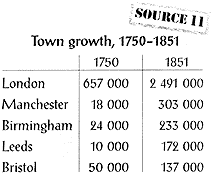 Town growth, 1750-1851
Town growth, 1750-1851
There are no accurate figures for the populations of these new industrial towns before 1801. Since then a census has taken place every decade. Historians make estimates for the years before 1801.
Social Conditions in Towns
The pollution and the filthy conditions that people were forced to live in resulted in the spread of diseases. From time to time, epidemics of smallpox and cholera broke out and the infant mortality ratewas much higher in the towns than in the country areas.
As more and more people flocked to the towns, unemployment increased. Where no member of the family was able to find work, whole families experienced terrible poverty and hardship. In despair people turned to drink and crime increased. For some, it was so bad that they died of starvation.
Working conditions
People often worked long hours, sometimes up to 18 hours a day. Factories were dark and badly ventilated. No compensationwas paid to workers when accidents occurred. Very often women and even children were employed because they could be paid lower wages than men. Children as young as including those from the orphanages, were forced to work for 12 to 14 hours a day.
Working conditions in the coal mines were even worse than in the factories. It was common for women to pull coal trucks along low and ark mine passages. Some of these passages were so low that only small children were able to crawl along them. Rock falls and other accidents were common. Many children became physically deformed because of their work.
Employers and workers in Britain
One of the most important effects of the Industrial Revolution in Britain was the division of British society into new groups or classes. There were now two main groups in the towns made up of the factory and themine owners. These were the employers who had the money with which to employ people who produced goods. Although not all employers held the same views, they shared aim of making a profit from the sale of products made by the people who worked for them.
The second group were the people who worked for the employers, as well as the unemployed. This group had to rely on employers for work in order to survive and became known as wage labourers or workers.
The system operated so that the only people who accumulated wealth were factory and mine owners. Many workers were underpaid and increasing unemployment resulted in competition over jobs and lowering of wages.
Early protests
With thousands of people moving to towns in the mid-1700s, there was a greater demand for food. This resulted in shortages which led to price increases. People began to organise public protests against low wages and high prices. There were 375 serious protests in Britain between 1730 and 1795.
Often the government sent the army to break up protest gatherings. Hundreds of people were shot or injured by soldiers during these protests.
After 1800 people in the towns began to unite to demand higher wages, better housing and the right to vote for representatives in parliament.
Workers' organisations in Britain
In 1799 and 1800 the government passed laws forbidding workers from strike action and making trade unions illegal. Trade unions organised and represent workers to protect their interests and to improve wages and working conditions.
Because they were made illegal, workers' leaders could be sentenced to death for trying to organise unions or strikes. While they struggled to win the right to belong to trade unions, British workers carried on organising secret unions and called successful strikes.
In 1828 British workers won the legal right to set up trade unions. Early attempts at setting up large trade unions failed. Slow communication and low levels of literacy made it very difficult to get everyone to agree to a common policy. It was only in the 1850s that some of these problems were solved. Different local groups combined at the time to form many of the unions, which still exist in Britain today.
A number of poems and songs show that workers believed that being part of trade union strengthened their position
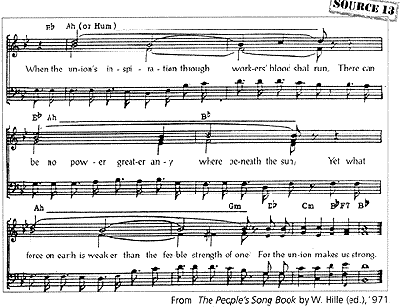 One song sung by workers all round the English-speaking world
One song sung by workers all round the English-speaking world

